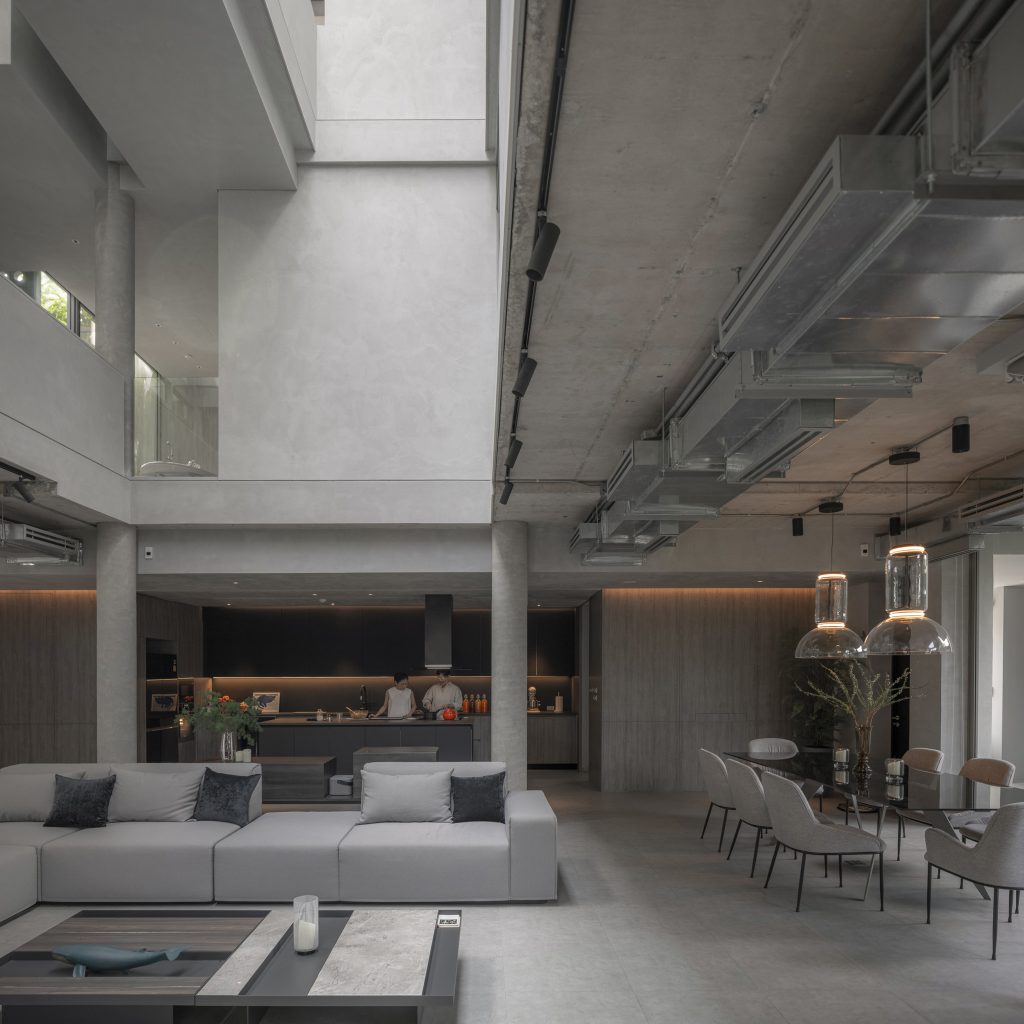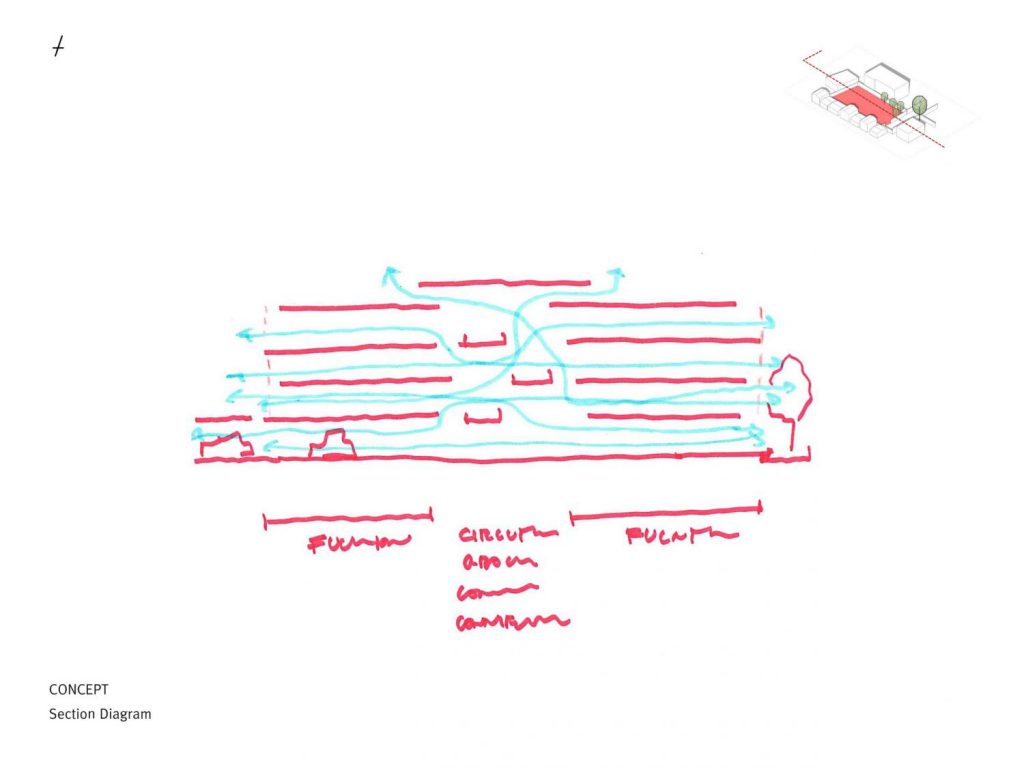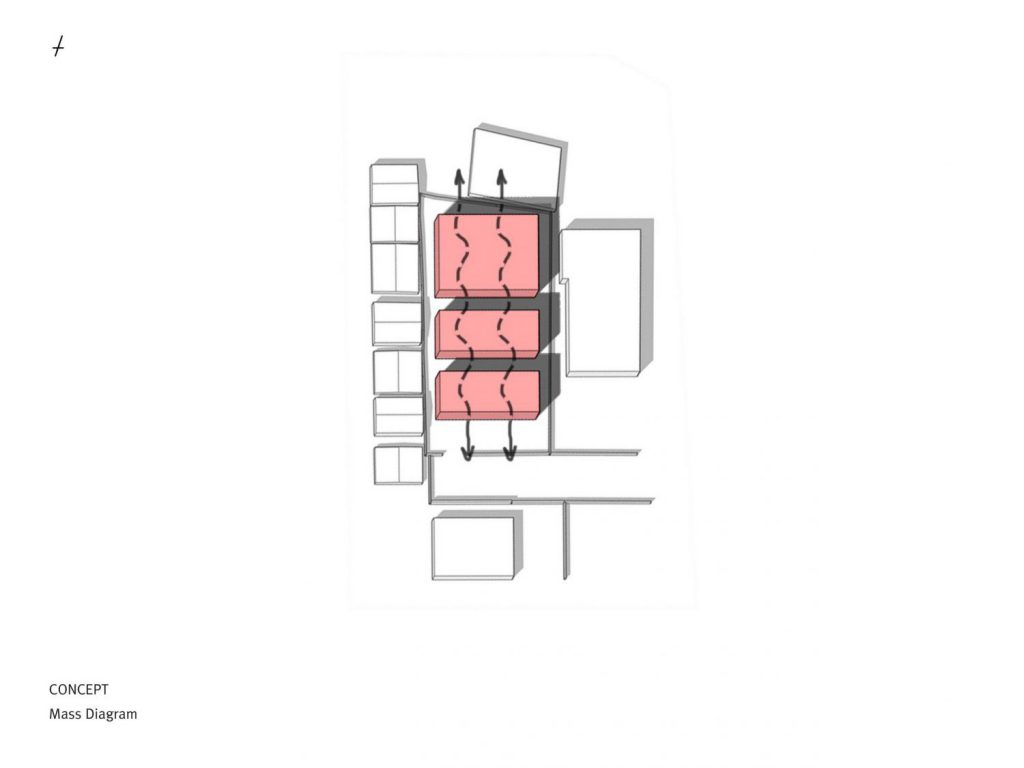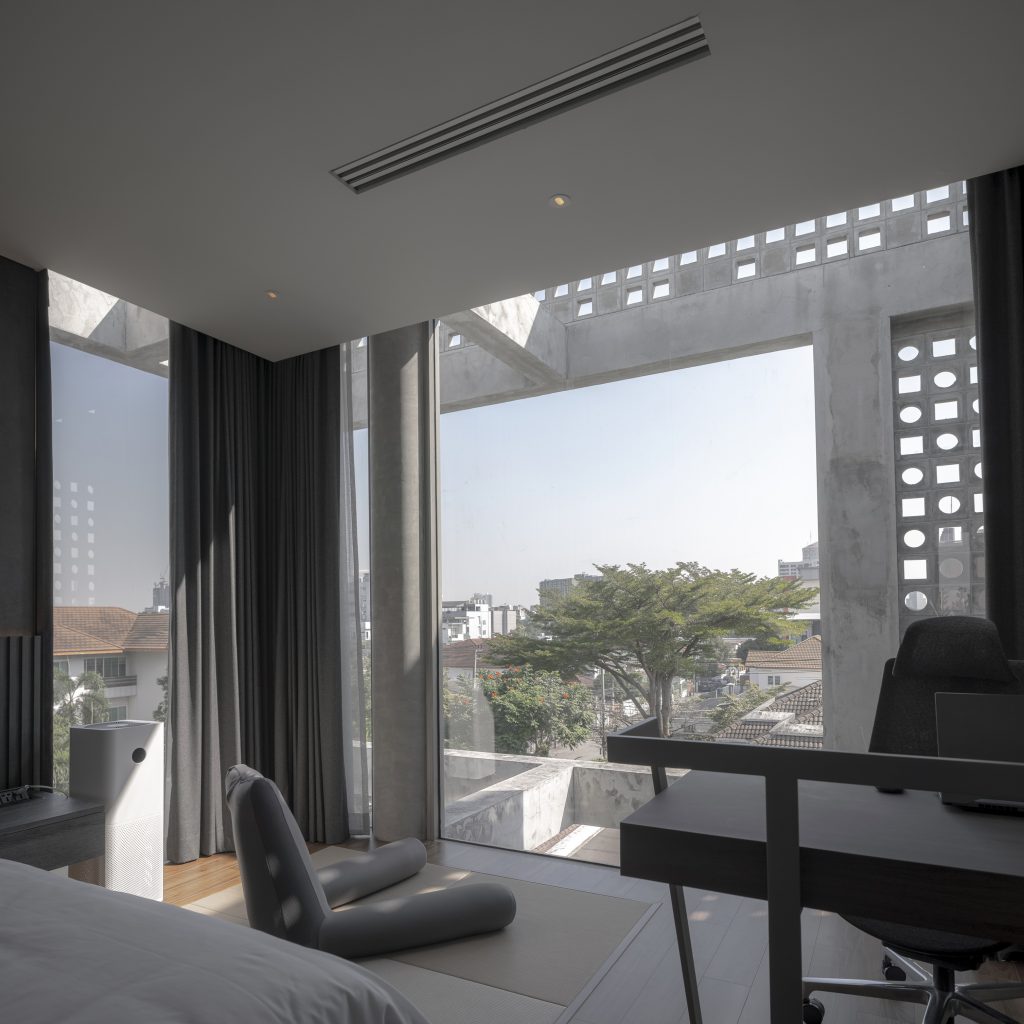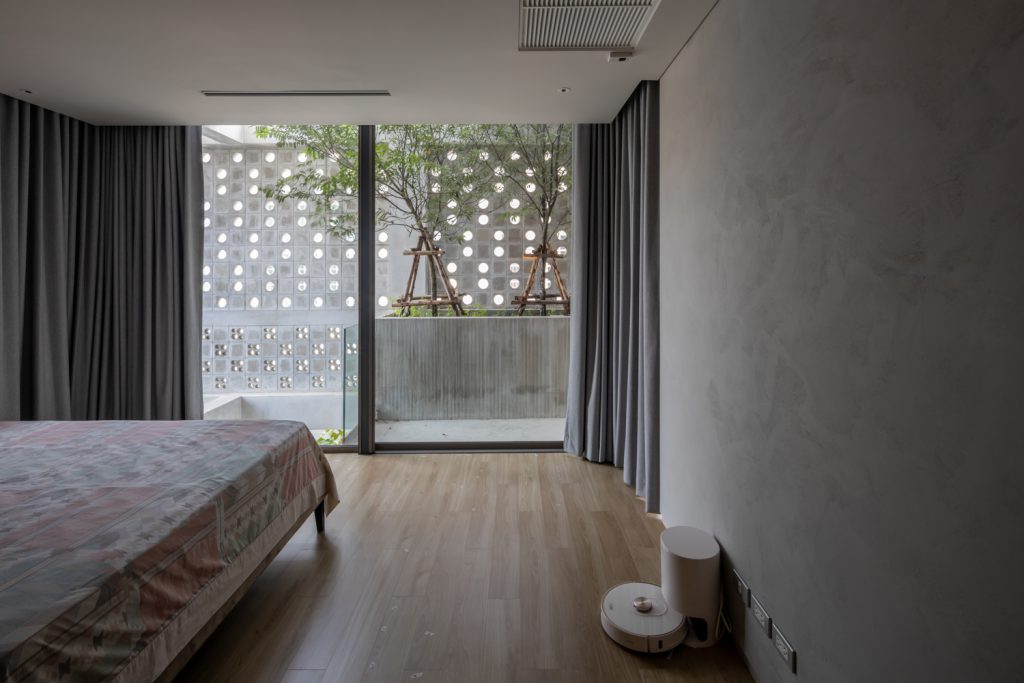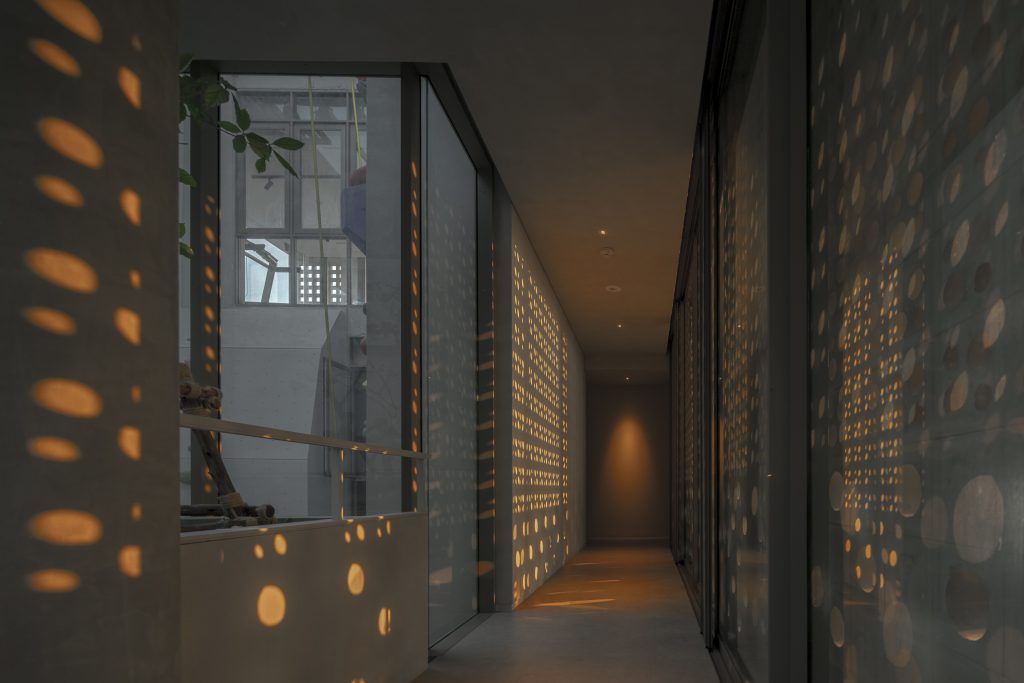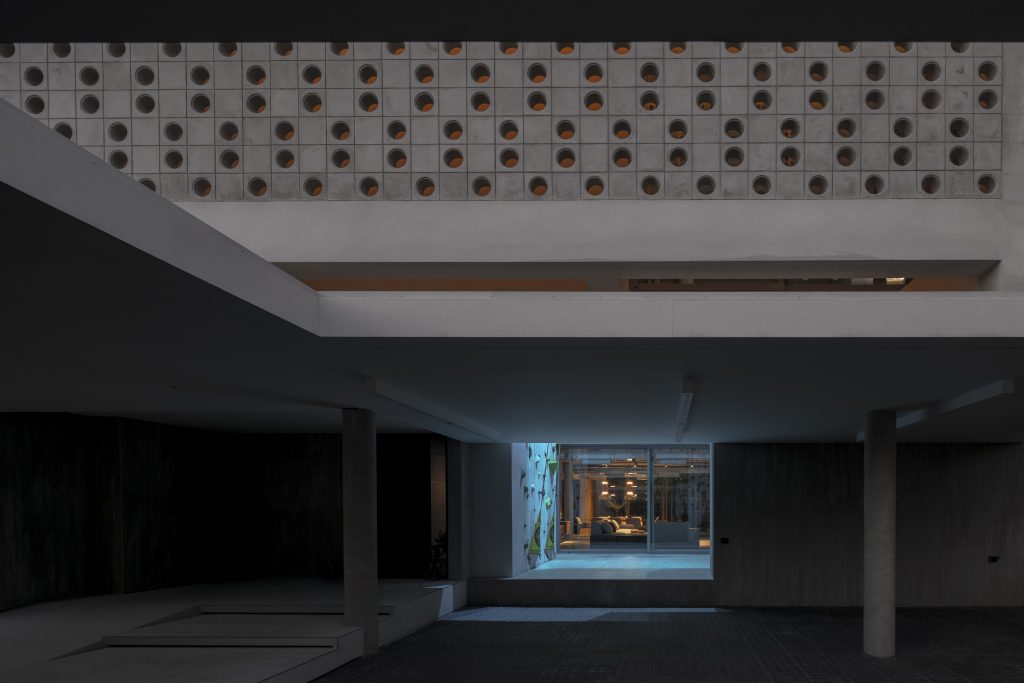Anonym Studio has brought out and harnessed the potentials of wind and sunlight to craft the happiest and most livable living space of this multi-family house.
Text: Nathanich Chaidee
Photo Courtesy of Anonym Studio, Soopakorn Srisakul and Ketsiree Wongwan except as noted
Download the online journal Issue 05 Home Smart Home Click here
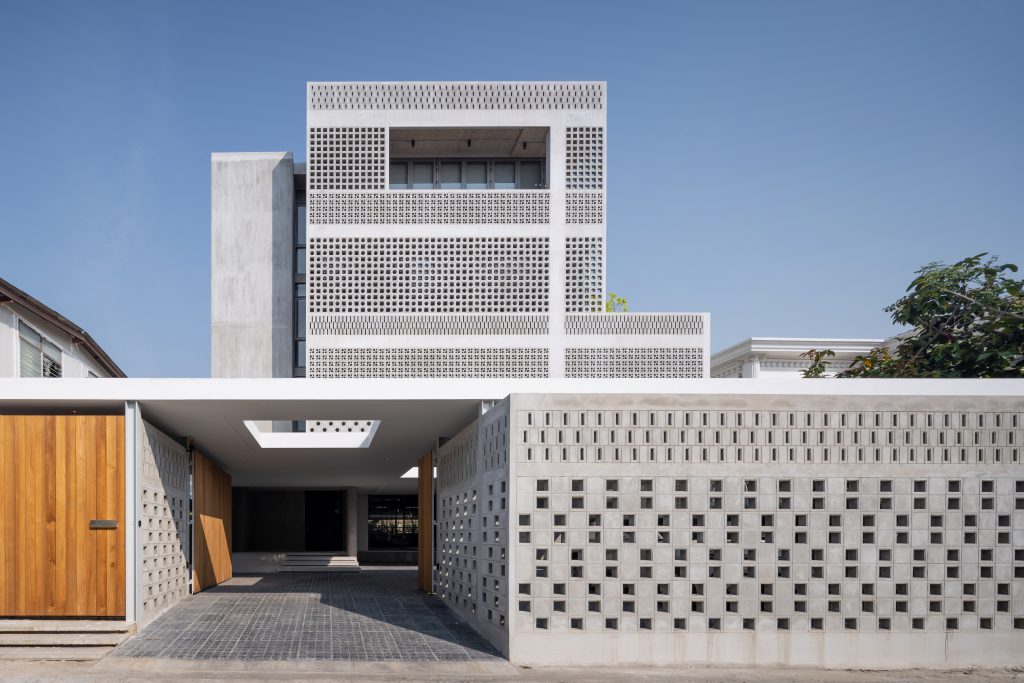
สัมผัสจากสายลมแรงผ่านช่องหน้าต่างบนชั้นสี่ของบ้าน คือที่มาของชื่อบ้านหลังนี้ที่นิยามจากเจ้าของบ้านโดยตรง ตอบรับกับเจตนารมณ์ของงานออกแบบสถาปัตยกรรมบ้านพักอาศัยขนาดสี่ชั้นหลังนี้ของ Anonym Studio ที่ต้องการดึงศักยภาพของทรัพยากรธรรมชาติของลมและแดด มาจัดการผ่านงานออกแบบเพื่อสร้างความสุขของผู้อยู่อาศัยให้ได้มากที่สุด ที่มาและความสมาร์ทของบ้านหลังนี้ในภาพรวมเรื่องของธรรมชาติเป็นสำคัญจากที่ตั้งของบ้านหลังนี้ที่หันหน้าออกทางทิศใต้ ซึ่งรับลมได้ดีมาก บวกกับบริบทของพื้นที่เอื้อกับสภาวะของลม คุณพงศ์ภัทร เอื้อสังคมเศรษฐ์ สถาปนิกจึงดึงเอาเรื่องพลวัตของลม จากการจดจำความรู้สึกที่ตรงนั้น มาพัฒนาเป็นงานสถาปัตยกรรม ซึ่งบ้านหลังนี้เป็นโปรเจ็คท์กึ่งๆ ทดลองในเรื่องภาวะอยู่สบายของบ้าน และทางสถาปนิกค่อนข้างมั่นใจมากว่าเป็นไปได้
ด้วยความต้องการบ้านสี่ชั้นสำหรับสามครอบครัว คือ ครอบครัวรุ่นลูก และครอบครัวรุ่นพ่อแม่ของทั้งสองฝั่ง โจทย์แรกของสถาปนิกจึงเป็นการออกแบบบ้านหลังนี้ให้เหมือนกับเป็น Serviced Apartment ให้แต่ละครอบครัวได้มีพื้นที่ส่วนตัวในแต่ละชั้นเป็นของตัวเอง ขณะเดียวกันกับชั้นล่างที่เป็นพื้นที่ส่วนกลางสำหรับรวมครอบครัวใหญ่ไว้ด้วยกัน ความรู้สึกจึงเป็นเรื่องสำคัญของครอบครัวที่จำเป็นจะต้องเชื่อมต่อ ทั้งในเรื่องความรู้สึกของการใช้งาน และความรู้สึกในแง่มุมของประสาทสัมผัสรอบด้านเพื่อคุณภาพชีวิตที่ดี ครอบคลุมตั้งแต่พื้นที่ส่วนตัวที่สุดไปถึงพื้นที่ส่วนรวมของทุกคน แก่นสารของความเป็น ‘บ้าน’ จึงถูกถ่ายทอดลงบนอาคารสี่ชั้นแห่งนี้ ด้วยการสร้าง Circulation หรือการหมุนเวียนของทางสัญจรในทุกมิติ ไม่ว่าจะเป็น Cross Circulation ของทางเดินในแนวระนาบที่ใช้งานในชีวิตประจำวัน และ Vertical Circulation หรือการไหลเวียนของทัศนวิสัยในแนวดิ่ง ด้วยการใช้ระเบียงวางสลับกันในแต่ละชั้น เพื่อสร้างจังหวะของพื้นที่และมุมมองที่เชื่อมโยงกัน ไปพร้อมกับการจัดสรรพื้นที่ภายในซึ่งช่วยสร้างประสบการณ์ใช้งานและกระชับความสัมพันธ์
พื้นที่ของอาคารจึงแบ่งออกเป็นสองด้าน ซึ่งเป็นพื้นที่ของห้องนอนที่เปิดหน้าต่างให้ลมพัดผ่านช่องเปิดได้ทั้งสองฝั่ง ส่วนหลังคาตรงกลางยกสูงขึ้นให้ลมสามารถทะลุทะลวงได้โดยรอบ โดยเว้นคอร์ทตรงกลางไว้ 2 คอร์ท คอร์ทแรกเป็นพื้นที่ส่วนกลางสำหรับครอบครัวที่สามารถมองเห็นห้องนั่งเล่น ห้องรับประทานอาหารได้ ส่วนคอร์ทที่สองเป็นพื้นที่ปีนผาของเจ้าของบ้าน ซึ่งจัดสรรเป็นพื้นที่แบบกึ่งเอาท์ดอร์ ให้ได้บรรยากาศของการออกกำลังกาย คอร์ทกลางของแต่ละชั้นจะมีจัดสรรช่องว่าง สะพานทางเดิน หรือระเบียงสลับกันไป เพื่อสร้างจังหวะในการมองเห็น พร้อมกับลดความเป็นทางการของอาคารสี่ชั้น เพิ่ม Sense of Place ของความเป็นบ้านให้มากขึ้นอีก เช่นเดียวกับช่องเปิดบันไดที่มีการบิดเปลี่ยนระนาบไปในแต่ละชั้น เพื่อสร้างเอฟเฟกต์ทางความรู้สึกที่อบอุ่นขึ้น โดยแต่ละช่องเปิดหรือมุมเล็กซอกน้อย จะมีการแทรกต้นไม้เป็นจุดรวมสายตาของผู้คนภายในครอบครัว และเป็นวิวสำหรับเพื่อนบ้านรอบข้างที่ว่า อาคารสูงสี่ชั้นแต่ทว่ายังดูโปร่งพร้อมกับเปิดมุมมองธรรมชาติให้กับความเป็นอยู่ในเมือง
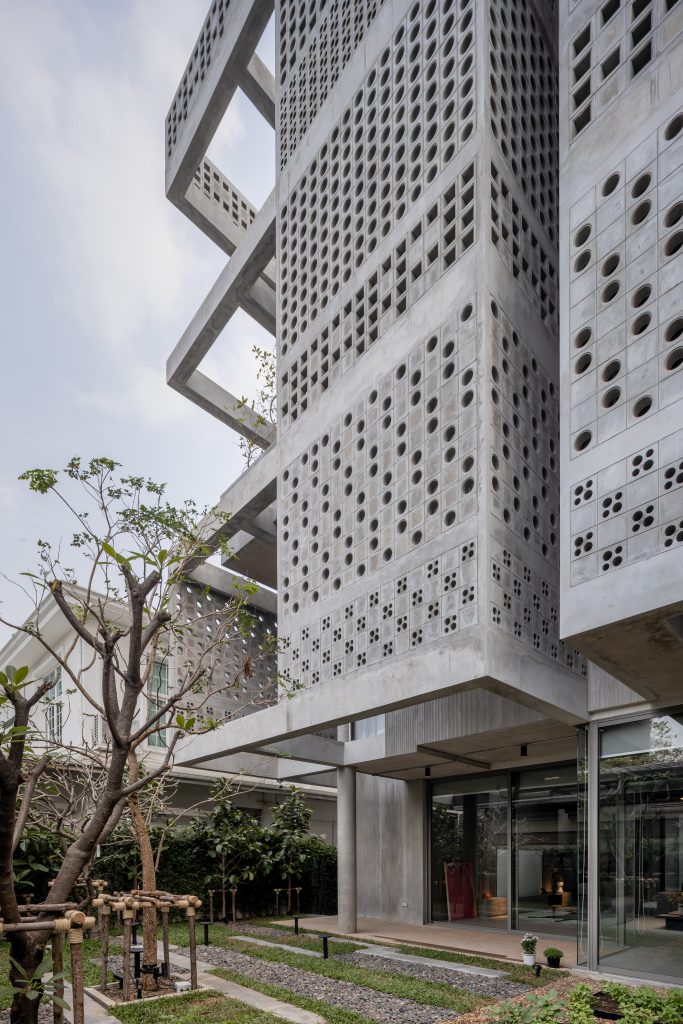
Ambiguity หรือความคลุมเครือ คือคีย์เวิร์ดที่สถาปนิกเลือกใช้กับวัสดุฟาซาดของบ้านหลังนี้ “เพราะคำว่า คลุมเครือ สามารถต่อยอดบทสนทนาระหว่างแต่ละองค์ประกอบของงานสถาปัตยกรรมด้วยกันเอง และกับคนทำงานได้ หลายครั้งที่งานวัสดุจะไปตกผลึกในไซต์งานระหว่างก่อสร้าง เราก็ดูตามสภาวะและมุมมองของพื้นที่” ส่วนของช่องลม คือความตั้งใจตั้งแต่แรกเริ่มของสถาปนิกว่าจะต้องใช้งาน เพราะด้วยลมธรรมชาติบริเวณบ้านหลังนี้ดีมาก และวัสดุอิฐช่องลมน่าจะดีที่สุดและเหมาะสมที่สุด ณ เวลานั้นในเรื่องของการดึงลมเข้าบ้าน พร้อมกับสร้างความปลอดภัยให้กับบ้านในเวลาเดียวกัน วัสดุส่วนงานฟาซาดอาคารแบ่งออกเป็น 2 แบบ ได้แก่ ผืนผนังคอนกรีตเซาะร่องตามแนวตั้งของอาคาร กับผืนผนังอิฐช่องลมที่ทำหน้าที่เป็นกรอบของงานสถาปัตยกรรมโดยรวม โดยใช้โครงสร้างของอาคาร การคว้านเจาะช่องเปิด และการกรุกระจก เป็นส่วนช่วยในการบรรจบองค์ประกอบทั้งหมดให้เชื่อมโยงเข้าด้วยกันอย่างกลมกลืน
ในการจัดวางแพทเทิร์นของอิฐช่องลม ผู้ออกแบบได้ศึกษาเรื่องความทึบ-ความโปร่งเพื่อจัดวางการไล่ระดับของความโปร่ง ให้สัมพันธ์กับรูปลักษณ์ของอิฐช่องลมแต่ละรุ่นที่มีหน้าตาและจำนวนของช่องเปิดแตกต่างกันไป อย่างในชั้นแรกจะดูทึบสุดด้วยเรื่องความเป็นส่วนตัว แล้วค่อยโปร่งขึ้นให้เห็นวิว ไล่ระดับขึ้นไปจนถึงชั้นบนสุด พร้อมกันนั้นก็ทำให้ช่องเปิดหลักของชั้นบนๆ เปิดออกมากขึ้นให้เห็นวิวทิวทัศน์นอกบ้าน หลายมุมของบ้านที่เปลี่ยนรูปแบบของการจัดวางผนังอิฐช่องลมล้อมปิดกับการเปิดช่องว่างกรุกระจกแทนในช่วงระหว่างการตรวจหน้างาน เพราะการปรับเปลี่ยนให้สอดประสานไปกับความรู้สึกจากเอฟเฟกต์ของมุมมอง แสง และลม ณ จุดนั้นจะเป็นการดึงศักยภาพของงานดีไซน์ที่มีผลต่อธรรมชาติของความเป็นอยู่ให้ได้มากที่สุด เอฟเฟกต์ของธรรมชาตินอกเหนือจากเรื่องลมแล้ว ยังเป็นเรื่องราวของแสงธรรมชาติที่ทอดกระทบบนผืนผนังต่างๆ และเปลี่ยนแปลงตามความเข้มของแสงตลอดวัน แสงธรรมชาติมีส่วนที่ช่วยสร้างความเชื่อมโยงผ่านมิติทางการมองเห็นมากขึ้น

“ส่วนตัวชอบโปรเจ็คท์นี้มาก เพราะรู้สึกว่ามันเปลี่ยนความคิดในเชิงการทำงานก่อสร้าง สถาปัตยกรรม และงานโครงสร้าง เพราะเป็นงานที่ปล่อยให้เป็นไปตามธรรมชาติ พื้นผิวคอนกรีตของเส้นแนวอิฐ สีธรรมชาติของอิฐช่องลม และการเลือกผนังวัสดุภายในที่เป็นซีเมนต์อิมพอร์ทสีเทา ที่เล่าเรื่องราวเดียวกันหมดทั้งตัวบ้าน ซึ่งแสงและลมช่วยเติมอารมณ์ให้บ้านมีชีวิต รวมทั้งส่วนงานโครงสร้างที่ทิ้งให้เห็นคาน ท่อ สายไฟ ตอนนี้ก็รู้สึกขอบคุณความคิดตรงนั้นที่ทำให้เราเปลี่ยนว่า มันก็ไม่จำเป็น ถ้ามันจะดิบก็ต้องปล่อยให้มันดิบไปเลย อย่าปรุงเยอะ”
สุดท้ายแล้ว ความสมาร์ทของบ้านหลังนี้ในสายตาของสถาปนิกเป็นอย่างไรนั้น สำหรับพงศ์ภัทรเขามองว่า “คำว่า ‘สมาร์ท’ ในมุมมองของการออกแบบบ้าน เราคิดว่า เป็นเรื่องของการจัดการทรัพยากรธรรมชาติที่มีอยู่แล้วทั้งลมและแสง เข้ามาสร้างสรรค์ให้เกิดศักยภาพสูงสุดเพื่อคุณภาพชีวิตที่ดีในการอยู่อาศัยผ่านองค์ความรู้และงานออกแบบสถาปัตยกรรม ยกตัวอย่างเรื่องแสงธรรมชาติ เราจะสามารถพัฒนาไปถึงเรื่องคุณภาพของแสงได้อย่างไร หรือประสบการณ์ของแต่ละช่วงเวลาของแสงที่แตกต่างกัน เราจะสามารถจัดวางสเปซหรือแทรกจังหวะอะไรบางอย่างเข้าไป แล้วสะท้อนให้สัมผัสความรู้สึกอย่างไรได้บ้าง อันนี้เป็นเรื่องสำคัญ”
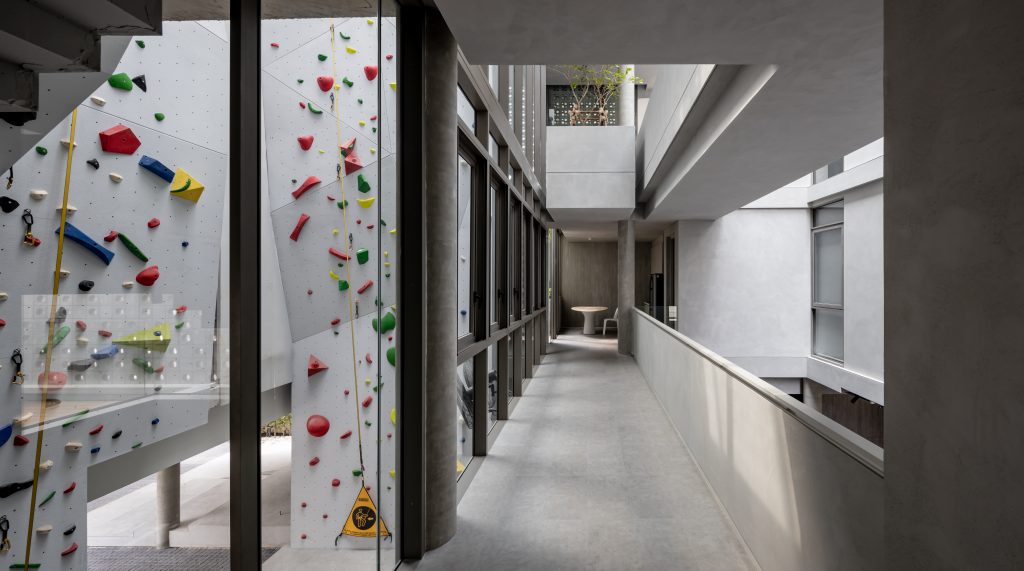
in the end, what makes the house smart, architecturally, is how the design manages the existing natural resources be it the wind or sunlight; how it maximizes the potentials of these natural elements to deliver the best possible quality of life through the use of an architectural body of knowledge. Take natural light, for example, how can we develop the quality of natural light in a living space or how can we curate living experiences from the way sunlight changes at different times of day, or how can we manipulate a space or insert some sort of rhythm to it to create or reflect discernible emotions? These factors are all important.
The genesis of Baan Sailom and what essentially makes it a ‘smart’ home is the elemental presence of nature, from the location and south-facing orientation that opens the house up to an abundant amount of wind, to the surrounding context of the site, which enhances the presence of wind. All of which are utilized in the design. Phongphat Ueasangkhomset, the principal architect and co-founder of Anonym Studio incorporates the dynamism of wind and the particular experiences it brings to the living spaces, developing the natural elements to become a part of the house’s architecture. The work is somewhat a semi-experimental approach the architect took to explore effects of thermal comfort in residential spaces; something Phongphat was confident would end up delivering a successful outcome.
With the brief to design a four-story house for three families (a husband, a wife and all four of their parents), the first task the architect needed to work with was to come up with the main functionality of the house, which would be something similar to that of a serviced apartment where each family is given their own private floor. Occupying the ground floor of the house are the common areas where all the family members gather and share the space. What the design is expected to deliver is a sense of connectivity between the physical spaces, be it private or common areas, and users’ sentiments and experiences that will ultimately create the best possible quality of life.
The essence of what a ‘home’ is thus conveyed through this four-story building, with the thoughtfully designed dimensions of the circulation, from the cross circulation of the horizontal walkways the inhabitants use on a daily basis, to the vertical circulation that creates a visual flow achieved through the alternating placement of the terraces, which facilitates a corresponding rhythm of spaces and perspectives. These architectural components work alongside the manipulation of interior spaces, and together, all the elements are integrated into cohesive spatial experiences and relationships.
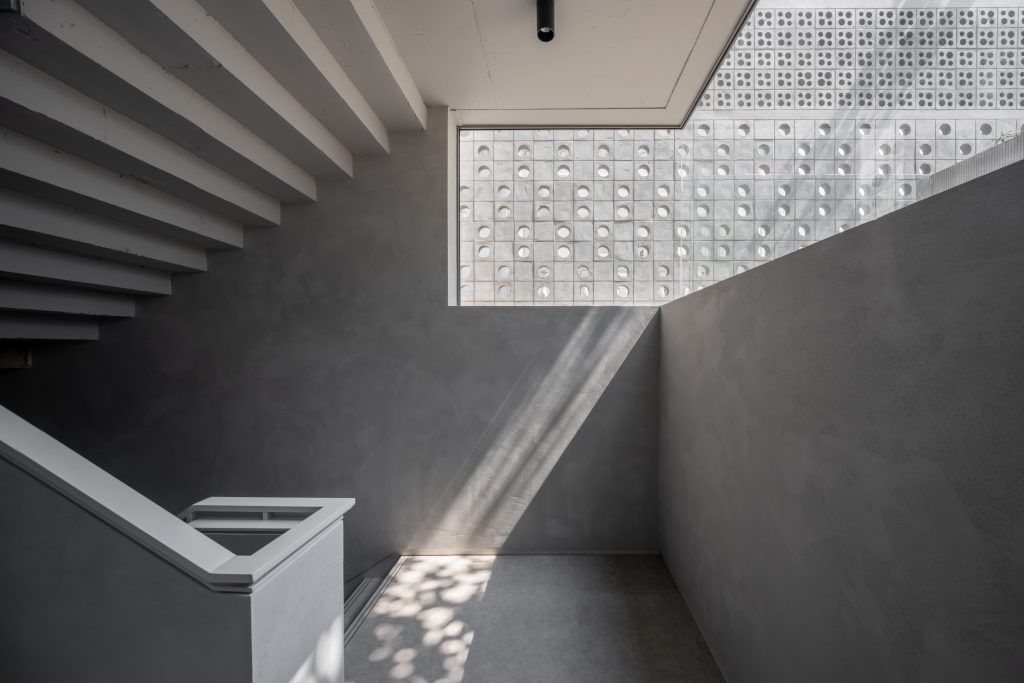
The design divides the building’s functional spaces into two wings, which house the sleeping quarters with windows that can be left open for wind to flow through. The centre of the roof is elevated for the airflow to work its way into the inside of the house. The first of the two courtyards is home to a common space with a visual access to the living area and dining room. The second courtyard is where the climbing wall is set up with the semi-outdoor space that gives off an energetic vibe of a workout zone. The courtyards on all the floors are designed to have alternating voids, passageways or terraces, and together they create a cadence of how the spaces are perceived and experienced while making the four-story building look and feel less formal with a sense of place that makes it a home.
The void at the staircases is designed to deviate into a different plane on each of the floors, making the space look and feel warmer and more intimate. Each opening or corner is decorated with trees or plants to create a nice focal point for dwellers. Meanwhile, the house itself becomes a visually pleasant view for the neighbours with the green elements beautifully crafted to make the entire architecture more open and natural, especially with its surrounding urban context.
Ambiguity is the keyword of the design of the facade. “The word ambiguity can be further ramified in the conversations that occur between all the architectural elements, as well as among the people who are involved in the project. There have been several occasions where decisions regarding the materials were made on site, while the construction was being carried out, because we looked at them based on the conditions and the perspectives the spaces would create at a certain period or moment.” The ventilation openings are among the architect’s initial intention to include in the design of the house considering the site’s ample airflow. Perforated concrete blocks became the most suitable alternative at the time as the material that can physically enhance the airflow and presence of natural wind inside the house’s interior spaces while still providing the needed privacy and security.

Material wise, the facade comprises a massive concrete wall with details of this minimal pattern of vertical grooves created entirely by hand, and the walls constructed using perforated concrete blocks, which also serves as the frame that defines the entire architectural mass of the house. The design makes use of the building’s structure, creating recessed openings and using transparent glass walls to help put all the compositions together in a cohesive, harmonious architectural language. The arrangement of the concrete blocks’ pattern is a thoughtful result of the architect’s study on how solidity and airiness can work together with the wall’s transitioning levels of density. The configuration corresponds with the physical attributes of the different types of perforated concrete blocks used. For the house’s first floor, the facade is constructed with the highest level of density for privacy purposes, before the mass gradually becomes more airy and open on the higher floors to grant the inhabitants better access to the view. The higher the floor, the more open the openings are to take in the outside surroundings.”
There are a number of parts where adjustments were made with the arrangement of concrete blocks and glass openings during the construction process. Having inspected the site at different phases of the construction, certain details were revised based on the architect’s observation of the actual perspectives, and how natural light, shadow and wind interact with the actual spaces. The approach ends up bringing out the best possible potential of the design and the effects it has on the way the owners live and interact within the living spaces. In addition to the wind, there are stories of natural light and shadow, and their presence on different surfaces at varying intensities and times of day, including the role of nature on the facilitated visual connection of the architecture and its spaces.
“I personally love this project because I feel that it changes the way I think and approach construction, architecture and structure because the entire process progresses very naturally. From the surface of the concrete blocks, the natural colors of the perforated blocks, the grey of the imported cement used with the interior walls, the natural wind and light that bring the house to life, to the exposed details of structural works from the beams, pipes, electrical cords, each existing as a part of this one narrative. I’m thankful for what changed my mindset which has made me let go and to allow certain things to reveal their rawness because not everything has to be embellished or polished.”
From the architect’s perspective, “in the end, what makes the house smart, architecturally, is how the design manages the existing natural resources be it the wind or sunlight; how it maximizes the potentials of these natural elements to deliver the best possible quality of life through the use of an architectural body of knowledge. Take natural light, for example, how can we develop the quality of natural light in a living space or how can we curate living experiences from the way sunlight changes at different times of day, or how can we manipulate a space or insert some sort of rhythm to it to create or reflect discernible emotions? These factors are all important.”




